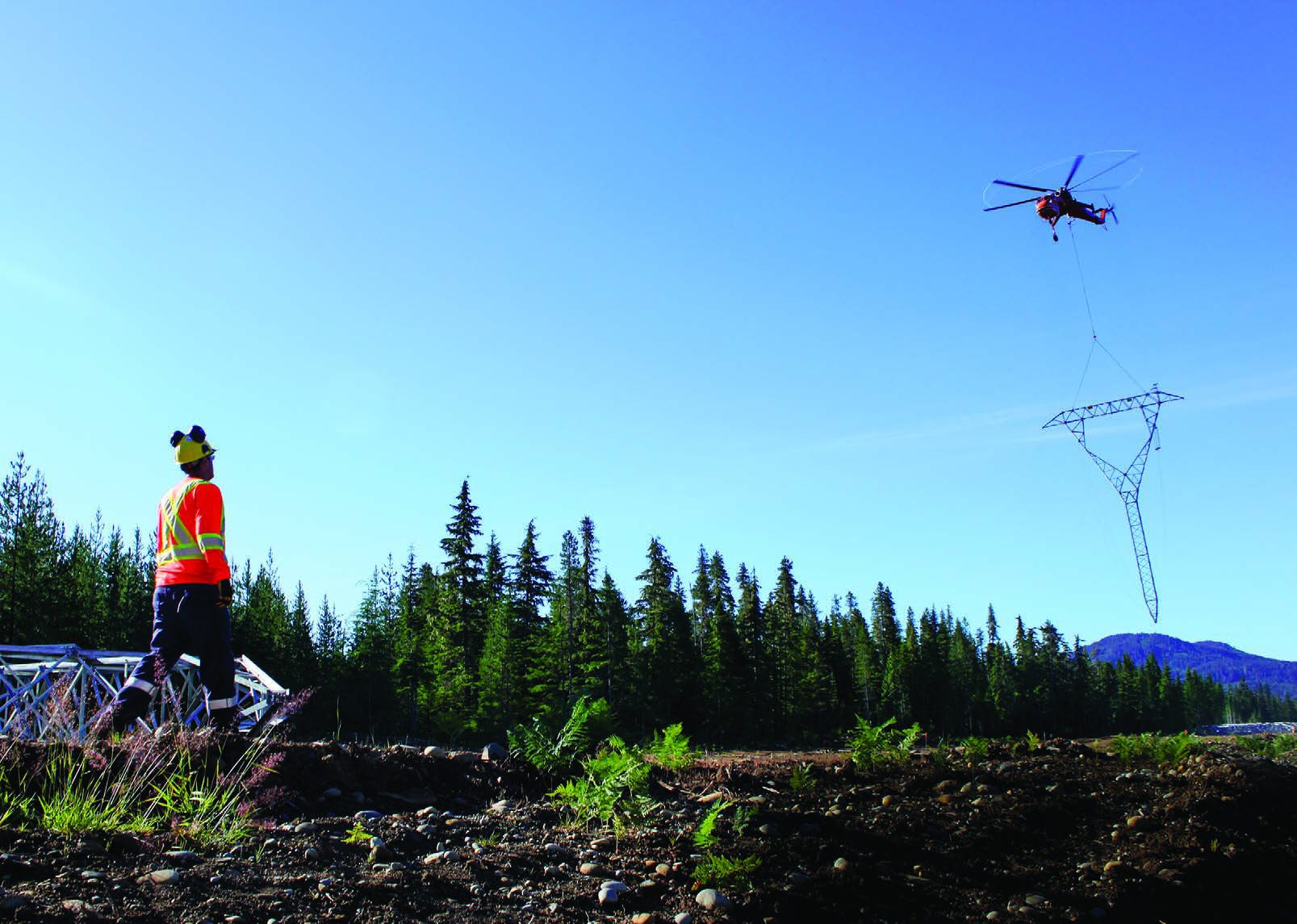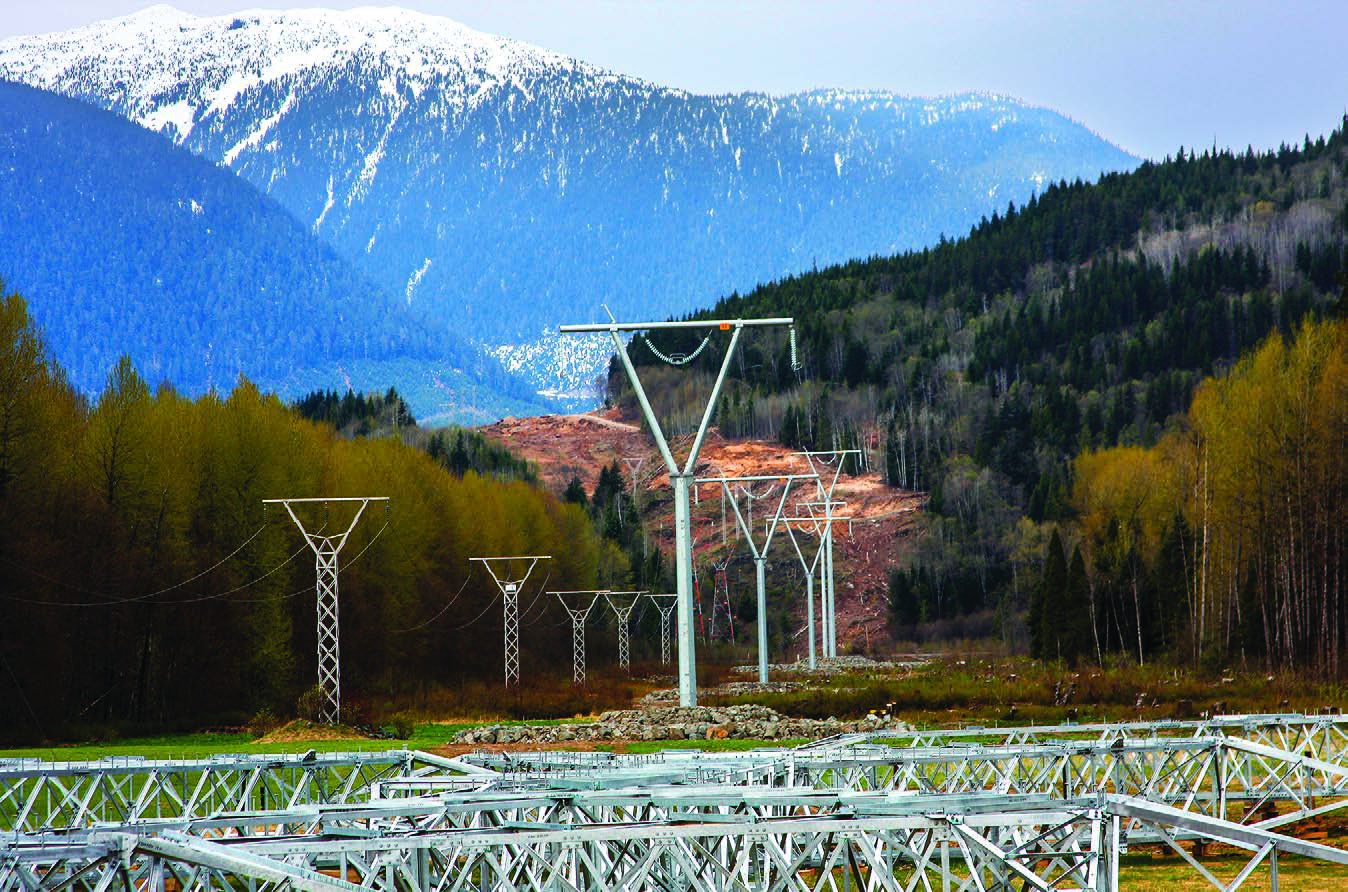
If you could chart 10 years’ worth of emotions stirred up by the Northwest Transmission Line (NTL) project, you’d have highs and lows to rival the Pacific Cordillera. There were anxious moments when the project looked like it would stall. And there was jubilation on August 13, 2014, when electricity officially began flowing along a 344-kilometre, 287-kilovolt transmission line, bringing a BC Hydro grid connection to northwest B.C. communities, mine developers and independent power producers.
Although the northwest holds as much as 30 per cent of B.C.’s mineral resources, it was held back for many decades by the absence of connection to BC Hydro’s grid. Diesel generators could keep the lights on in communities along Highway 37, and they made a high-grade gold silver deposit such as Eskay Creek a viable mine. But they weren’t adequate to enable development of the sprawling, low-grade deposits that are typical of the northwest.
The idea of a BC Hydro transmission connection was first broached with government in 2004 by Donald McInnes, then-president of Western Keltic Mines and proponent for a copper-zinc mine at Kutcho Creek. McInnes explained that B.C. was an under-performer against comparable jurisdictions for attracting mineral exploration investment. A transmission line carrying affordable grid power to the northwest would be the catalyst for change, he argued.
Energy and Mines Minister Bill Bennett, who was minister of state for mining during the early stages of the campaign (and eventually presided over the completion of NTL by BC Hydro in August 2014), decided to take a look for himself. “I flew into Red Chris, I flew into Galore Creek. I stayed about five days up along Highway 37 in the local lodges just to learn what was going on up there. I became convinced that if we did build a power line, investment would come,” Bennett recalls.
Back in Victoria, however, with the 2010 Winter Olympics on the horizon, Bennett found “it was difficult, frankly, to turn the attention to a part of the province that was almost forgotten.”
But a bigger coalition was beginning to build. There were key members, including the Association for Mineral Exploration BC, the Mining Association of BC (MABC), Northern Development Initiative Trust, and some well-connected First Nation leaders including Gitxsan Hereditary Chief Elmer Derrick.

“MABC and AME BC were strongly aligned to build a coalition that was bigger than industry,” says AME BC president and CEO Gavin Dirom. “A lot of private companies, suppliers, small businesses in the northwest, communities including Terrace and Smithers, mayors and councillors, and First Nations, for the most part, were behind this.”
Byng Giraud, who served as general secretary for the Highway 37 Power Line Coalition during consecutive stints with AME BC, MABC and Imperial Metals, said the organization’s greatest asset was its grassroots support.
According to Giraud, there was no effort to manage the message, or the tone, in overtures to government. “Everybody got the information, everybody was empowered and everybody was a spokesperson,” he says. “It may not be the message you particularly might think is best, but it’s their message. And that’s what made it work.
“I remember one local welder on his own volition was running ads in the local papers, supporting the power line.” Initially, the coalition’s economic argument for NTL was bolstered by plans for a massive copper-gold-silver mine at Galore Creek. In 2007, however, things turned bleak when partners Teck Resources and NovaGold Resources decided to reconsider Galore Creek’s economics.
Former Terrace mayor Dave Pernarowski, now an account manager with PR Associates, recalls what happened next.
“We heard that Galore was being basically shelved,” Pernarowski says. A group of NTL proponents in Terrace got in vehicles and hurried to Smithers just in time to catch Finance Minister Colin Hansen at the airport. “We talked about the need to continue with the engineering and an environmental process on the power line, about all the potential projects that were on stream to be connected to that line.”
The province wasn’t convinced. It halted preliminary work on NTL and pulled back from a $250-million commitment toward it. So a group of mining companies pitched in $300,000 for an independent study. Released in 2008 by MABC, the study said northwest mineral deposits had the potential to supercharge mine development in the region – $15 billion in new investment, almost 11,000 new jobs, and $300 million per year in new tax revenue.
Aside from the economics, other things began to shift in the coalition’s favour.
“I think the tipping point for the line,” says Imperial Metals chairman Pierre Lebel, “was these communities of the north coming together and saying, ‘This is a really good thing for us. We’re over reliant on the forest industry, we’ve got pine kill issues, we have to generate new sources of economic development, and this line is going to be pivotal to that objective.’”
A second circumstance was the 2008 recession. Lebel recalls that the federal government was looking for “shovel-ready” infrastructure projects to stimulate the economy. NTL conformed to Ottawa’s desire for projects with a “green” component – such as switching Highway 37 communities from diesel to hydroelectricity. A $130-million commitment of federal funding, championed in Ottawa by Prince George–Peace River MP Jay Hill, helped offset B.C.’s financial risk.
A third was coalition pressure on the government of thenpremier Gordon Campbell. When the premier walked into the 2008 Minerals North conference in Smithers, he was greeted by hundreds of people wearing black-and-yellow Power 37 hats.
“During his presentation, he donned the hat and kind of joked that he might be putting on the most expensive hat ever,” Dirom recalls. “He was classy about it, and funny at the same time.”
A fourth circumstance was Imperial Metals’ large, robust Red Chris copper-gold project, which had environmental permits in place and was steadily moving ahead. Red Chris was the lynchpin project NTL needed to restore momentum, Dirom says.
Finally, a fifth circumstance was that AltaGas began putting together the $725-million Forrest Kerr hydro project, including a $180-million construction agreement towards the cost of the new transmission line. .
B.C. got back on board, heralding NTL as a good choice for federal funding. Prime Minister Stephen Harper accepted that recommendation, announcing $130 million towards the power line in September 2009. BC Hydro, after consulting with numerous First Nations, announced in 2011 that NTL would proceed – starting at Skeena Substation near Terrace, with a 334-kilometre first phase running north to a new substation at Bob Quinn Lake.
By December 2014, Imperial Metals had invested $643 million into construction of Red Chris and expected to be making concentrate for shipping in early 2015. The mine at full operation will provide up to 325 well-paying, full-time jobs.
“A lot of people believe that the NTL is something the province is paying for, and for certain they have fronted significant costs,” Lebel said. “But so has Imperial Metals, and so has AltaGas – there are tariffs that have to be paid back to the province with interest. So it becomes an extraordinary investment for the province.”
The opening of Red Chris is just the first of many mine investments that AME BC anticipates in the coming years as a result of NTL, according to Dirom. “This area is world class in terms of prospects, speaking of the northwest in general and the Golden Triangle specifically. Huge deposits, and very rich deposits, have been discovered.”
Galore Creek is still on the books and, in December 2014, Seabridge Gold announced that the federal government had given environmental approval to its KSM gold project. A short list could also include the Arctos Anthracite Project, Schaft Creek, Snowfield, Turnagain, Brucejack, Kutcho Creek, Bronson Slope and GJ.
“Schaft Creek isn’t too far away, not to mention Galore Creek,” Dirom says. “As well, we’ve seen huge excitement in the last two years with Brucejack right in this same area. The table is now set for success.”
